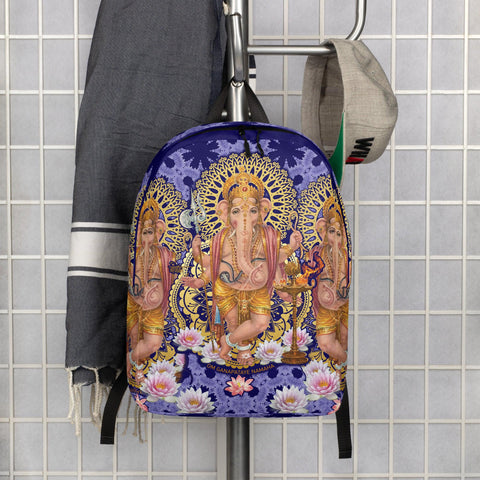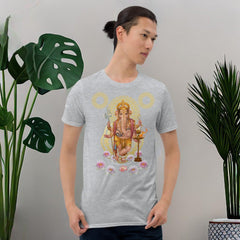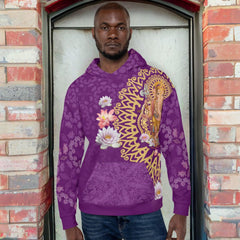Ganesh with Mouse: Mythological Tale of Lord Ganesha and His Vahana
Posted by Massimiliano Geraci

Discovering the deep connections between deities and their vahanas in Hindu mythology opens a fascinating window into ancient wisdom. Often, these pairings reveal intricate teachings about balance, humility, and the natural world.
In central and western India, the mouse began to appear as Ganesha's primary vehicle in sculptures during the 7th century, reflecting regional mythological and symbolic beliefs.
One such intriguing partnership that captures imagination is that of Lord Ganesha - the remover of obstacles - and his unique vahana, the mouse. This pairing might raise eyebrows at first glance: a mighty deity known for his wisdom riding atop a tiny mouse.
The story behind why Lord Ganesha’s vehicle is a mouse weaves together themes of transformation, humility, and service. Surprisingly to some, this small creature plays a critical role in symbolizing the ability to move through life’s nooks and corners effectively, overcoming obstacles just as Ganesha does for devotees.
Our blog post delves into this mythological tale, exploring everything in its path and narrative arc from the Matsya Purana and Ganesha Purana and its symbolism within Hinduism.
By understanding how the humble mouse became so pivotal in mythology and what it represents when depicted alongside Ganesha’s statues or images across India, readers will gain insights into higher spiritual concepts masked by simple allegories.
Get ready to explore!
Why is the Mouse the Vahana of Lord Ganesha?
The mouse, as the vahana of Lord Ganesha, captures a profound symbolism deeply rooted in Hindu mythology. This pairing of a mighty deity, often referred to as the elephant god, with a seemingly insignificant rodent reflects the importance of humility and intelligence over brute force.
In ancient scriptures, notably the Brahmananda Purana and Ganesha Purana, this unique relationship is explored through tales where Ganesha’s wisdom conquers obstacles that sheer power cannot.
The choice of the mouse underscores agriculture’s vital role during those times while addressing greed and arrogance, teaching followers that even small beings and animals called rodents can hold immense significance.
Krauncha, once a celestial musician-god cursed to become a giant mouse by Sage Vamadeva for accidentally stepping on his foot, symbolizes transformation and redemption through serving under Ganesha’s feet.
This story signifies forgiveness and how servitude towards higher wisdom leads to liberation from one’s egoistic form. It elucidates how Lord Shiva’s son chose Krauncha transformed into his vehicle – depicting how enlightenment can make formidable challenges surmountable by maneuvering through narrow pathways, tiny holes and narrow pathways unnoticed but impactful.
Each depiction of Ganesha standing or seated with his mouse vividly illustrates overcoming obstacles because his vehicle adroitly conquers everything in its path, embodying Vighnaharta - the remover of obstacles‘ essence.

Origin of Ganesha's Mouse Vehicle
Lord Ganesha’s vehicle, a mouse, symbolizes the ability to penetrate even in the darkness and crush significant obstacles with agility and intelligence. This unique choice of vahana underscores Hindu iconography’s rich symbolism, where gods choose vehicles that complement their qualities or mission.
The story traces back to ancient texts like the Brahmanda Purana and Ganesha Purana, which narrate how this tiny creature became associated with one of Hinduism’s most beloved deities.
In many depictions, the mouse is often seen near Lord Ganesha's feet, symbolizing its role in helping the deity overcome obstacles.
According to these sacred writings, Krauncha—one of the celestial musicians—was transformed into huge form of a mouse by a curse. After causing havoc by eating stored grains and standing crops, crucial for agriculture—the primary source of prosperity in ancient times—he came under Lord Ganesha’s foot.
Ashamed by his destructive nature and recognizing Lord Ganesha’s divinity, Krauncha begged pleaded the god for mercy. In return for his plea, Lord Ganesha made him a mouse rat his vahana, symbolizing humility and wisdom conquering pride. The humble mouse teaches us that no being is very big menace too small to bear the weight of Lord Ganesh. However, when Ganesha mounted on Krauncha, he couldnt bear the weight of Lord Ganesha. This narrative captivates spirituality and Indios art lovers and conveys timeless lessons on overcoming obstacles with grace and intelligence—a core principle embodied by Lord Ganesha the god himself.
The Story of Krauncha: The Giant Mouse
Krauncha, once a celestial musician in the divine assembly of gods, found himself transformed into a giant mouse due to a curse. This twist of fate led him to wreak havoc at Sage Parashar’s ashram, disrupting meditations and consuming vast amounts of stored grains.
His immense size and appetite posed significant challenges, turning him from a revered figure into an invincible pest within the confines of sacred spaces.
Muni Vamadeva, distressed by Krauncha’s actions yet aware of his true identity, sought a solution that would restore harmony while teaching the cursed being a valuable lesson. The intervention came from Lord Ganesha who, upon witnessing Krauncha’s turmoil and understanding his inner suffering, decided to turn one story of this tale of destruction into one of redemption.
By subduing Krauncha easily and taking him as his vahana (vehicle), Lord Ganesh not only reclaimed peace for the ashram but also restored dignity and purpose to Krauncha’s existence.
This unique bond between deity and mount first appears in scripts around the 7th century, symbolizing wisdom conquering pride and demonstrating how even those deemed as pests can serve divine purposes under guidance.

Symbolism of the Mouse in Hindu Mythology
Transitioning from the narrative of Krauncha, the transformation of this giant mouse into the vahana of Lord Ganesha reveals profound layers of symbolism in Hindu mythology. The mouse, often depicted alongside the deity, serves as a powerful emblem within this spiritual tapestry.
This small creature embodies humility and intelligence, traits highly valued in Hindu culture. Its role as the vehicle for one of Hinduism's most worshipped gods and deities underscores a message that greatness does not solely depend on physical might but also on wisdom and modesty.
In engaging with this symbol further, we appreciate how the mouse represents an essential aspect of human existence—mind and its control. Just as a mouse can slip through tiny holes and cracks and consume stored food, thereby being seen as a pest (organism), it parallels how thoughts can infiltrate our mind space unbidden, leading to mental clutter or destruction if left unchecked.
Lord Ganesha’s mastery over such a seemingly insignificant creature signifies his control over the mind's prowess and distractions. Thus, having conquered this "pest," he teaches us about overcoming obstacles by mastering our minds—a lesson deeply embedded within agriculture-centric communities where elephants were revered for their power and mice feared for potential destructions they could cause to crops.
Through these interwoven narratives and symbols, adherents find meaningful paths toward enlightenment guided by humility (symbolized by the humble mouse) under Ganesha’s divine presence.
How Did the Mouse Become Lord Ganesha's Vehicle?
The tale of how the mouse became Lord Ganesha‘s vehicle is steeped in layers of mythology and spiritual symbolism, deeply enshrined within Hindu literature. Central to this story is Krauncha, once a musician in the court of Lord Indra, who was transformed into a giant mouse due to a curse from Rishi Vamadeva.
This mischievous creature began causing havoc, destroying the sanctity of hermitages by gnawing through everything in sight. In an act that exhibits both compassion and command over obstacles, Lord Ganesha subdued Krauncha, stepping and stepped on the foot of his foot gently but firmly.
Recognizing the error of his ways and seeking redemption for his actions under the curse’s influence, Krauncha requested to serve as the Lord's vehicle - ganesha's rat vehicle as vehicle. Thus, teaching him a lesson in humility and service. Lord Ganesha obliged; symbolically adopting Krauncha represented more than just conquering this pest. It underscored profound themes pervasive throughout Hindu mythology: transformation through grace, wisdom overcoming impulse, and the deity’s role as ‘remover of obstacles.’ This narrative illustrates why Ganesha rides atop a mouse and imbues each depiction with rich meaning - from sculptures gracing temples to images adorning homes worldwide. In becoming the vehicle of Lord Ganesh, known widely for his wisdom and benevolence toward devotees’ prayers for obstacle removals (symbolized by Gajanana representing intelligence), Krauncha transcended his cursed form - serving as an enduring reminder across ages that even the most insignificant among us can rise to divine purpose under compassionate guidance.
The Mythological Tale Behind the Mouse
In the mythological narratives that enrich Hindu tradition, the mouse became Lord Ganesha’s vahana (vehicle) through a remarkable story of transformation and redemption. Krauncha, originally a celestial musician in the court of Indra, was cursed to become a massive mouse by Sage Vaamadeva after accidentally stepping on his foot.
In this tale, Lord Ganesha humbled Krauncha by subduing him, showcasing his ability to destroy obstacles and challenges.
This curse not only altered Krauncha’s form but also set the stage for his future role alongside one of Hinduism’s most revered deities.
Lord Ganesha is able to teach profound lessons through this partnership with his tiny vehicle; together they symbolize wisdom, agility, and the ability to overcome obstacles no matter their size or nature.
The presence of Lord Ganesha riding atop his mouse steed serves as a constant lesson that intelligence and might can coexist in harmony, revealing deep spiritual truths about overcoming pride and embracing humility.
Through this tale, followers are encouraged to look beyond external appearances and recognize the immense potential within all beings, regardless of their size or stature.
The Curse and Transformation of Krauncha
Transitioning from the enchanting story behind Ganesha's unique selection of his vehicle, we now explore a crucial chapter that unveils how Krauncha, originally not a mouse, came to embody this significant role.
The pivotal moment arrives with Sage Vamadeva who, in an act that intertwines destiny and morality, unleashes a curse upon Krauncha. This incident is not merely about punitive action severe punishment, but serves as a profound teaching moment for both Krauncha and those who learn of his tale.
Krauncha accidentally stepped on the foot of Sage Vamadeva during one fateful encounter. Reacting to the disrespect shown towards him, Vamadeva cursed Krauncha to become a mouse. Yet, this curse was far from ordinary; it carried layers of lessons about humility and transformation.
Despite its initial appearance as misfortune, being condemned to such form allowed Krauchna to cross paths with Lord Ganesha. In turn, Ganesha acknowledges the humble yet mighty heart within this tiny creature by bestowing upon it the honor of becoming his vahana (vehicle).
Through their bond—a symbol of wisdom conquering pestilence—both demonstrate the power of unlikeliest alliances in overcoming life's hurdles.
Role of Sage Vamadeva in the Tale
Sage Vamadeva, a revered figure in Hindu mythology, plays a pivotal role in the transformation of the celestial being Krauncha into Lord Ganesha's vahana. Through his deep wisdom and understanding of dharma, Vamadecha pronounced a curse on Krauncha for his arrogance.
This crucial act led to Krauncha's last incarnation, as Ganesha's mouse vehicle. The sage’s involvement highlights the importance of humility and service in spiritual growth.
Vamadeva's actions also underscore the interconnectedness of all life forms within Hindu teachings. His intervention serves as a reminder that every creature has its place and purpose within the divine plan.
By facilitating Krauncha’s journey to redemption and service by becoming Ganesha’s carrier, Sage Vamadeva teaches him a valuable lesson about devotion and duty. This narrative from the Puranas enriches our understanding of Ganesha and illustrates how sages like Vamadeva shape the moral landscape of mythological tales through their wisdom and actions.
What Does the Mouse Symbolize in the Presence of Lord Ganesha?
The mouse, often seen at the feet of Lord Ganesha, holds profound symbolism in Hindu mythology. This tiny creature represents humility and intelligence, qualities closely associated with Ganesha himself. The mouse is often depicted at Ganesha's feet, symbolizing its role in helping the deity navigate and overcome obstacles.
The paradox of a mighty deity choosing such a humble vahana underscores the importance of wisdom over physical strength and signifies that even the smallest can conquer obstacles through intellect and wit.
By pairing with a mouse, Ganesha teaches his followers to look beyond superficial appearances and value innate wisdom.
This motif also illustrates the harmony between seemingly opposite forces—strength and vulnerability, size and significance—highlighting that balance is key in overcoming life’s hurdles.
As this partnership navigates challenges together, it reveals how diverse elements can unite for greater purposes. Moving from images of Ganesh’s vaahana to depictions in art allows us to explore how artisans have visually represented these concepts across cultures.

Humility and Wisdom in Hinduism
In Hinduism, humility and wisdom stand as pillars that elevate the soul towards enlightenment. Ganesha's partnership with his vahana, a mouse named Krauncha (Ganesh's mount), serves as an allegory for these virtues.
This union teaches us that even the most powerful beings value modesty and intellect, proving that true strength lies in one's character rather than physical might. Lord Ganesh, revered across world religions and depicted alongside various animals like lions, peacocks, and horses in different cultures, showcases the universal appeal of humility and wisdom.
Ganesha’s vehicle choice underscores the message that every creature has its significance in the larger cosmic order. The story begins with sage Vamadeva cursing Krauncha into a mouse form yet ends with this humble creature becoming pivotal to Ganesha’s mythology—highlighting how transformations lead to unexpected roles in life’s divine play.
This narrative invites anthropology enthusiasts, spirituality seekers, and Indian art lovers to reflect on personal growth through understanding ancient tales.
Even the smallest among us can teach us lessons of great importance.
Overcoming Obstacles with Ganesha's Vahana
Ganesha, revered as the remover of obstacles, finds a profound symbol in His vahana, the mouse. This humble creature embodies agility and the capacity to penetrate through barriers, much like Ganesha's ability to handle challenges life presents.
The mouse’s significance transcends its physical attributes, representing a spiritual tool for penetrating the difficulties with wisdom and grace. By choosing such a small yet mighty animal as His vehicle, Ganesha teaches humility and demonstrates that size does not constrain one's power to overcome hurdles.
The relationship between Ganesha and His vahana illustrates how intelligence and insight can conquer adversity more effectively than brute strength alone. In tales from sacred texts like the Brahmananda Purana and Ganesha Purana, moments where Ganesha encountered demons or obstacles often highlight how intellect—symbolized by His choice of the mouse—triumphs over force.
This dynamic partnership between deity and vahana encourages devotees to adopt similar strategies in their lives: facing challenges with mental agility rather than relying on sheer force alone.
Through this symbolic association, Ganesha’s vahana becomes not just a conveyance but a teaching tool about mastering life’s trials using inner qualities of resilience and strategic thinking.
How is the Mouse Often Depicted with Ganesha Statues?
In Ganesha statues, the mouse typically appears at Ganesha’s feet or near his vahana, embodying a powerful symbol of humility and intelligence. Artists intricately carve these figures with attention to detail, capturing the essence of Ganesha’s vehicle in various materials ranging from stone to metal.
The practice of worshipping idols, including those of Ganesha with his mouse, holds deep cultural and historical significance, symbolizing protection and overcoming obstacles.
The depiction varies widely but often shows the mouse looking up towards Ganesha, signifying its role as a devoted servant ready to carry out the deity’s commands. This imagery reinforces the theme of might paired with modesty—a mighty deity choosing a tiny creature as his vehicle.
Sculptors also incorporate elements such as pasha (noose), dhumraketu (flag), and sometimes even agricultural motifs to highlight Ganesha’s role as “conqueror of obstacles“ and his connections to agriculture—a primary livelihood in ancient times.
These artistic variations reflect regional styles and embed deep spiritual meaning within each portrayal, inviting devotees and art lovers alike into a meditative exploration of their significance.
The next section explores different mythological tales involving Ganesha and His Mouse that further illuminate this unique divine relationship.
Common Imagery in Ganesha Statues
Ganesha statues often feature the deity with his vahana, a mouse, symbolizing the unity of opposites and underscoring themes of humility and intelligence. This pairing serves as a visual metaphor for overcoming obstacles, where Ganesha embodies wisdom and strength, while the mouse represents agility and modesty.
Sculptors carefully craft these images to capture not only the physical attributes but also the spiritual essence that these figures convey within Hindu tradition.
Artistic depictions vary greatly but commonly portray Ganesha seated or standing with a small mouse near his feet or looking up at him, highlighting their bond. Intricate details may include Ganesha holding sweet treats or writing utensils like those used by Saraswati, signifying education and knowledge.
Similarly, variations in posture and accessories reflect different aspects of Ganesha's role in world religions as a remover of obstacles and patron of arts and sciences. These statues serve not just as decorative pieces but as profound symbols for devotees seeking guidance in their pursuits.
Variations in Artistic Depictions
Artists have long captured the enigmatic bond between Ganesha and his mouse in varied, imaginative ways. These depictions honor the deity's significance in world religions and reflect cultural interpretations and artistic nuances.
1. Classical Portrayals: Traditionally, sculptures and paintings from ancient temples showcase the mouse sitting at Ganesha's feet, looking up in admiration. This demonstrates a deep respect and servitude towards the lord, aligning with Hindu beliefs of humility and wisdom.
2. Modern Interpretations: Contemporary artists experiment with abstract forms where the mouse symbolizes different aspects of life's journey, such as overcoming obstacles or seeking knowledge. Here, Ganesha often appears riding the mouse, guiding it through mazes that represent life's challenges.
3. Cultural Fusion: In some regions, artists blend local styles with traditional motifs, creating unique interpretations of Ganesha's vahana. For instance, Southeast Asian depictions might incorporate elements from local folklore or use native materials, adding regional significance to this divine relationship.
4. Digital Art and Animation: With the advent of digital media, Ganesha and his mouse have been reimagined in various animated forms that appeal to younger audiences. These versions sometimes place them in fantastical settings or modern-day scenarios, making ancient mythology relatable to present times.
5. Symbolic Contrasts: Artisans often play with contrasts between Ganesha's grandeur and the mouse's modesty to highlight their symbolic relationship - wisdom coupled with humility. Some representations may even feature peafowl or serpents nearby, adding layers of meaning about nature and divinity.
6. Festive Decorations: During festivals like Ganesh Chaturthi, public and home altars display elaborate models that include interesting variations of the mouse in different materials like clay or plaster of Paris. These celebratory depictions focus on joyous aspects of Ganesha’s persona alongside his trusted vahana.
7. International Influence: Across cultures embracing Hindu deities into their spiritual practices, interpretations include influences from other world religions or artistic movements like surrealism or pop art, showcasing how Ganesha’s image transcends geographical boundaries.
8. Educational Tools: In efforts to teach children about Hinduism and its deities, books and interactive exhibits depict Ganesha’s adventures with his mouse using vibrant illustrations that capture young imaginations while imparting moral lessons tied to spirituality.
Each variation invites viewers into a deeper understanding of Lord Ganesha’s teachings through the lens of artistry and devotion across cultures.
What Are Other Mythological Tales Involving Ganesha and His Mouse?
In the sacred texts of the Brahmananda Purana, Ganesha and his mouse confront numerous demons that pose threats to cosmic harmony. These stories illustrate not just the might of Lord Ganesha but also highlight how his vahana (lord's vehicle), seemingly insignificant in size, aids in overcoming formidable challenges.
In western India, these tales are particularly popular, reflecting regional beliefs and mythological traditions.
For instance, one tale recounts a fierce battle against a demon whose powers threatened agriculture, which was the primary livelihood for many. Here, Lord Ganesha strategizes with his mouse to ingeniously conquer this pest, thereby safeguarding prosperity and teaching him a lesson on humility.
Another captivating narrative from the Ganesha Purana details an adventure where Lord Ganesha employs his intelligence and wit to outsmart a powerful adversary intent on causing destruction.
The story beautifully demonstrates how Ganesha’s vehicle plays a crucial role beyond mere transportation; it becomes an integral part of the deity’s strategy to restore balance and ensure peace prevails.
Through these tales, devotees learn about wisdom, perseverance, and the importance of humility — core teachings reflected in Hindu spirituality brought vividly to life through the relationship between Ganesha and his mouse.
Stories from Brahmananda Purana and Ganesha Purana
Exploring the depths of the Brahmananda Purana and Ganesha Purana reveals profound tales that illuminate Lord Ganesha's wisdom and his choice of vahana, mouse or rat or vehicle. These scriptures narrate instances where Ganesha, with his mouse by his side, sets out on divine missions to remove obstacles from the path of righteousness.
They reveal how this unique duo symbolizes humility and intelligence, traits essential for spiritual growth and overcoming earthly challenges.
The Ganesha Puris offer stories and delve into lessons behind each narrative, teaching followers about devotion, wisdom, and the importance of humility in life's journey. Through engaging parables involving demons conquered and obstacles surmounted, readers learn why agriculture was once considered sacred and how even the smallest creatures play pivotal roles in the balance of nature.
These ancient texts guide individuals to a deeper understanding of Hinduism's rich tapestry woven through deities like Shani Devi as protectors against adversity.
Ganesha's Encounters with Demons and Obstacles
Lord Ganesha, often hailed as the destroyer of obstacles, demonstrates his prowess and wisdom through numerous mythological tales where he confronts demons. One such narrative unfolds in the ancient texts where Ganesha combats the demon Analasura, who embodies fire and threatens cosmic balance.
Using his divine power, Ganesha ingests the demon, symbolically asserting that even the most formidable challenges can be conquered with intellect and inner strength.
In another significant episode from Hindu mythology, Lord Ganesha teaches a lesson to Krauncha—the one who became his vahana or vehicle—by humbly transforming him into a mouse.
This act reflects Ganesha's ability to overcome adversity and serves as a profound teaching moment on humility and transformation. Through these encounters, Lord Ganesha epitomizes the ultimate vanquisher of impediments, guiding devotees to handle life’s hurdles with grace and courage.
Why is Lord Ganesha’s Vehicle a Mouse?
In Hindu mythology, the choice of a mouse as Ganesha's vehicle, or "vahana," intertwines spirituality with symbolisms of humility and intelligence. This tiny creature represents an unparalleled contrast to Ganesha's mighty persona, embodying the deity's power to conquer obstacles, regardless of their size.
Through this association, devotees learn that even the smallest beings in whole world hold immense significance in achieving spiritual enlightenment and overcoming life’s hurdles.
The legend behind the to become a mouse as Ganesha's vahana ties back to Krauncha, once a celestial musician cursed to become a huge mountain sized mouse with sharp teeth. This transformation was not just a whimsical tale but served as a lesson that every entity has its place within the cosmic balance.
Sage Vamadeva’s role in this story highlights the importance of wisdom and understanding in rectifying our mistakes. By riding on the back of what was once considered a pest in agriculture—the primary livelihood for many—Ganesha teaches us that mastering control over desires and fears leads to true liberation.
Symbol of Humility and Intelligence
Choosing a mouse as the vehicle for Ganesha, a mighty deity, serves as a profound reminder of humility and intelligence in Hindu teachings. The tiny creature contrasts sharply with the formidable form of Ganesha, symbolizing that greatness does not depend on physical size but on mental strength and wisdom.
This pairing highlights how intelligence can conquer obstacles far greater than brute force can. It teaches us to appreciate the modesty in beings and situations that appear insignificant at first glance.
This unique combination also addresses overcoming hurdles through cleverness rather than sheer power. Mice, known for their ability to slither into the smallest cracks, represent the ability to find solutions in tight spots where mightier forces fail.
They embody agility and adaptability - qualities essential for handling life’s challenges effectively. Thus, by making a mouse his vahana (vehicle), Ganesha becomes accessible to all worshippers irrespective of their socio-economic status, emphasizing that wisdom is key to surmounting life's obstacles.
Mighty Deity, Tiny Vehicle: The Contrast
Lord Ganesha, one of the most revered deities in Hindu mythology, commands power and wisdom. His vehicle, a tiny mouse, presents a striking contrast that intrigues many devotees and scholars alike.
This pairing underscores a profound message embedded within Hindu spirituality - strength lies not in physical stature but in mastery over one's ego and intelligence to overcome obstacles.
The mouse, often considered an agricultural pest representing desires that can gnaw away at our foundations, becomes conquered under Ganesha’s guidance.
The choice of such a small creature as the vahana for Ganesha symbolizes humility and the ability to penetrate through narrow spaces - metaphorically suggesting the deity’s capability to navigate through tricky situations with ease.
The symbiosis between Ganesha and his mouse teaches us valuable lessons about balancing might with modesty and intelligence with insight. Through this divine combination, followers learn that overcoming life's challenges requires wisdom to conquer this 'pest' within us all.






















